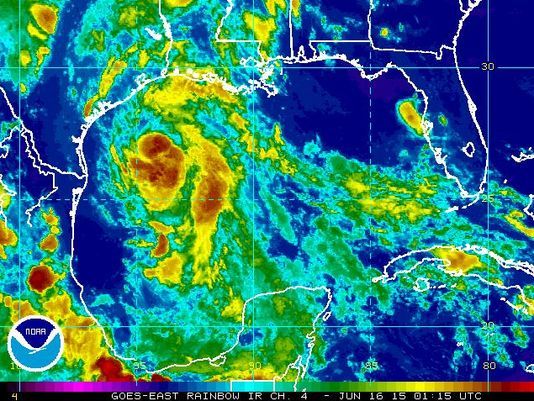
Tropical Storm Bill formed in the Gulf of Mexico, leaving Texas bracing for another round of flooding in less than a month.
Bill, which prompted some energy companies to evacuate non- essential personnel earlier, has sustained top wind speeds of 50 miles per hour (80 kilometers per hour), the National Hurricane Center said in an 11 p.m. New York time advisory. It was located about 155 miles south-southeast of Galveston, Texas, moving northwest at a speed of 12 mph.
Tropical storm warnings were in effect from Baffin Bay to High Island, Texas, the Miami-based agency said.
“The center of Bill is expected to make landfall in the warning area along the Texas coast Tuesday morning and move inland over south-central Texas Tuesday afternoon and Tuesday night,” the NHC said in the advisory.
Bill is the second named storm of the six-month Atlantic hurricane season that began June 1. It’s forecast to bring as much as 8 inches (20 centimeters) of rain over eastern Texas and eastern Oklahoma and 2 to 4 inches over western Louisiana and western Arkansas, according to the NHC.
Gulf storms are watched closely by energy markets because offshore platforms in federal waters account for 17 percent of U.S. crude oil output and 4 percent of natural gas production, according to the Energy Department. More than 45 percent of U.S. refining capacity and 51 percent of gas-processing capacity is located along the Gulf coast.
Royal Dutch Shell Plc removed some non-essential workers from the Gulf and doesn’t expect weather to affect operations, Ray Fisher, a company spokesman, said in an e-mail.
Helicopter Evacuations
Lafayette, Louisiana-based helicopter company PHI Inc. evacuated workers from some oil platforms in the western Gulf at the request of its customers, Chief Administrative Officer Richard Rovinelli said in an e-mail. He declined to identify the operators or say how many workers were moved.
Natural gas for July delivery added 1 percent to $2.917 per million British thermal units in electronic trading on the New York Mercantile Exchange at 9:29 a.m. Singapore time Tuesday, extending a 5.1 percent jump in the previous session. West Texas Intermediate crude traded 0.8 percent higher at $60 a barrel on Nymex.
Producers will likely avoid significant losses in output as a result of the storm because the system is in the western Gulf of Mexico, said Andy Lipow, president of Lipow Oil Associates in Houston.
“And 90 percent of the oil and gas production is south and east of New Orleans so there is very little in Texas waters,” he said.
Texas Floods
Heavy rains are forecast to bring floods to eastern Texas, including Houston, which was hit hard in May.
In Houston, roads were closed and 2,516 homes, as well as 73 commercial buildings, were damaged by floods last month, according to the Harris County Regional Joint Information Center. At least 31 people died across Texas and Oklahoma, the Weather Channel said.
National Weather Service regional offices have issued flash flood watches and flood warnings across much of eastern Texas north into Oklahoma and east in the Louisiana.
“The main thing is just going to be the flooding rainfall that we are going to see,” said Alan Reppart, a meteorologist at commercial forecaster AccuWeather Inc. in State College, Pennsylvania.
Rain should begin in Houston overnight, and spread throughout Texas Tuesday and Wednesday, he said.
Texas has opened its State Operations Center to deal with the storm, Governor Greg Abbott said on his website. Residents are urged to follow weather forecasts and prepare an emergency kit and for flooding.
Dallas will open its emergency center at 6 p.m. Tuesday, the city said in a statement.
In the Pacific, Hurricane Carlos, with top winds of 75 mph, was about 100 miles west-southwest of Lazaro Cardenas, Mexico, the hurricane center said in a statement at 11 p.m. New York time. The storm is forecast to maintain strength for the next few days before weakening.
Recommended for you
